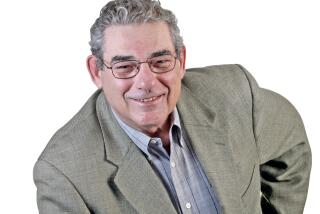Ed Cray, prolific author and L.A. journalist, dies at 86
Ed Cray, a longtime L.A. journalist and prolific author who wrote about famous Americans as far-flung as Chief Justice Earl Warren and California serial killer Juan Corona, has died. He was 86.
Cray was battling congestive heart failure and Alzheimer’s disease when he died Oct. 8 in Palo Alto, his daughter Jennifer said.
“We were cantankerous, opinionated journalists often at odds over some journalism course or curriculum idea or some administrative issue,” said fellow USC journalism professor Joe Saltzman in an online forum. “He was a wonderful colleague who really cared about journalism, about students, about what was right and what was wrong.”
Over the course of a decades-long teaching career at USC’s Annenberg School for Communication and Journalism, Cray inspired a generation of future journalists, helping many land jobs at newspapers and television and radio stations.
During print journalism’s golden era over four decades starting in the 1960s, Cray wrote 500 freelance articles and reviews for the country’s leading newspapers and magazines, including the Washington Post and the New York Times. He was a longtime contributor to the Los Angeles Times.
He wrote 18 books including biographies about the Depression-era folk singer Woody Guthrie and Warren. His Guthrie biography, “Ramblin’ Man: The Life and Times of Woody Guthrie,” served as the source material for the 2006 PBS “American Masters” documentary on the singer. In “Chief Justice,” Cray interviewed 45 of Warren’s former law clerks and won the American Bar Assn. award for best law book.
The Times praised Cray for his remarkable “dexterity” in handling the complexities and contradictions of Guthrie’s life. The New York Times said the book “vividly conveys how difficult Guthrie’s life was and how heroic his achievement.”
Cray’s book topics were diverse: He wrote a biography of World War II Gen. George Marshall, investigated General Motors’ early history in “Chrome Colossus” and delved into the psyche of Corona, who murdered 25 migrant farmworkers and buried their bodies in the peach groves along the Feather River. In “Levi’s,” he detailed the San Francisco clothing company’s history and mid-20th century challenges.
His 1990 book, “American Datelines” — a co-written analysis and collection of news stories about famous historical events — is still used as a textbook in many journalism schools.
In 2010, Cray received a Grammy nomination for the liner notes he wrote for “My Dusty Road,” Rounder Records’ four-CD compilation of 60 long-lost Guthrie songs.
Cray, considered a folklore expert, in 2011 edited two volumes of “Bawdy Songbooks of the Romantic Period,” a four-volume set of songbooks with extensive margin notes on mid-19th century folklore.
Born July 3, 1933, in Cleveland, Cray arrived as a young child in Los Angeles and grew up mostly in the Fairfax District. At 13, he inspected walnut crates in the San Fernando Valley as one of his first jobs. At 11, he sold the Los Angeles Mirror on city streets, remembering mobster Mickey Cohen as a frequent customer.
He joined the Los Angeles Daily News in 1948 as a copy boy and later worked as a wire reporter for City News Service in Los Angeles. After serving in the U.S. Army in Korea, he graduated from UCLA in 1957 with an anthropology degree.
Cray worked and freelanced for numerous Southern California newspapers, including The Times and the Hollywood Reporter, and wrote books examining social issues of the period, such as “In Failing Health,” a look at the healthcare industry, and “The Big Blue Line” about police malfeasance and corruption.
From 1965 to 1970, Cray was director of publications for the American Civil Liberties Union of Southern California. He also worked in the early 1970s as the publicist for the Los Angeles Philharmonic.
Geoffrey Cowan, the former USC Annenberg dean, remembered the many friendships Cray nurtured as a mentor for the school’s faculty, staff and students. Cray retired from the school in 2014, as professor emeritus.
“He cared deeply about his students and about the fate of his craft and his school,” Cowan said. “Ed was a fine journalist and a first-rate biographer.”
In 2017, Cray moved from Santa Monica to Palo Alto, where he lived until his death.
Besides his daughter, Cray is survived by two granddaughters, Emily and Tessa.
More to Read
Start your day right
Sign up for Essential California for the L.A. Times biggest news, features and recommendations in your inbox six days a week.
You may occasionally receive promotional content from the Los Angeles Times.






